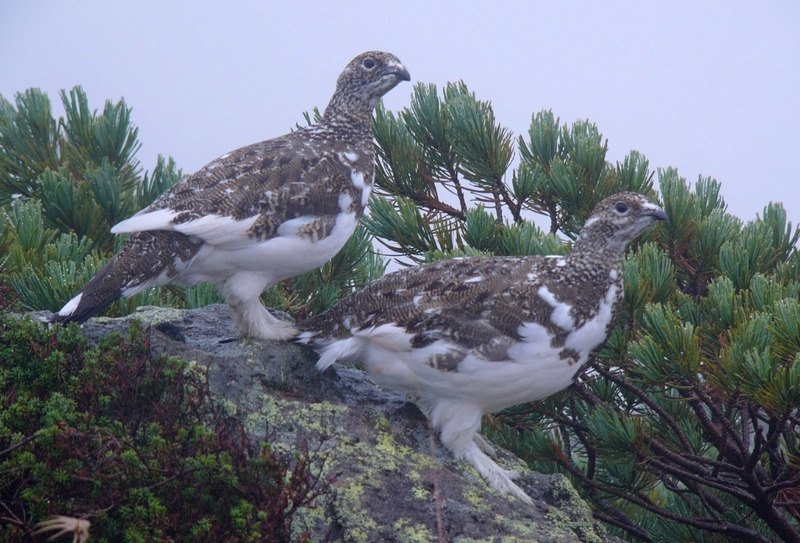|
| Query: birds of america | Result: 695th of 1888 | |
Rock Ptarmigan (Lagopus muta) - Wiki
| Subject: | Rock Ptarmigan (Lagopus muta) - Wiki
| |

| Resolution: 2304x1563
File Size: 699944 Bytes
Date: 2005:10:08 07:33:50
Camera: DMC-FZ10 (Panasonic)
F number: f/2.8
Exposure: 10/800 sec
Focal Length: 316/10
Upload Date: 2007:10:26 11:06:14
|
Ptarmigan
From Wikipedia, the free encyclopedia
[Photo] Rock Ptarmigan (Lagopus muta); Scientific name: Lagopus mutus. Two raichou (Lagopus muta japonica) in autumn plumage. This bird lives in Hokkaido and the high mountain zone in Japan. A Raichou will become pure white if winter comes. This photograph is the middle of becoming white. It is specified for the natural monument in Japan. Source: Photo taken by Kumaapr9 at Kumonotaira in North-Alps in Japan. Date: 2005/10/8. Author: Kumaapr9 (http://commons.wikimedia.org/wiki/User:Kumaapr9). Explanation in Japanese: 冬毛に???わる途中のライチョウ。北アルプスの雲の平にてKumaapr9が撮影。足元はもう???っ白です。 | Permission is granted to copy, distribute and/or modify this document under the terms of the GNU Free Documentation License, Version 1.2 or any later version published by the Free Software Foundation; with no Invariant Sections, no Front-Cover Texts, and no Back-Cover Texts. A copy of the license is included in the section entitled "GNU Free Documentation License". |
The Ptarmigan, Lagopus muta, is a medium-sized (31-35 cm or 12-14 inches) gamebird in the grouse family. It is known as Rock Ptarmigan, or colloquially Snow Chicken in North America, where it is the official bird for the territory of Nunavut, Canada.
It is a sedentary species, breeding across arctic and subarctic Eurasia and North America (including Greenland) on rocky mountainsides and tundra. There are isolated populations in the mountains of Scotland, the Pyrenees, the Alps, Bulgaria, the Urals, the Pamir Mountains, the Altay Mountains and Japan. During the last ice age, the species was far more widespread in continental Europe (Tomek & Boche??ski 2005).
The Ptarmigan is seasonally camouflaged; its feathers moult from white in winter to brown in spring or summer. Breeding males have greyish upper parts with white wings and underparts. In winter, plumage becomes completely white except for the black tail. They can be distinguished from the winter Willow Grouse (Willow Ptarmigan in North America) by habitat - Rock Ptarmigan prefer higher elevations and more barren habitat; they are also smaller in size with a more delicate bill.
The male's "song" is a loud croaking.
Ptarmigan feed primarily on birch and willow buds and catkins when available. They will also take various seeds, leaves, flowers and berries of other plant species. Insects are also taken by the developing young.
Folklore
In the mountains of Honsh??, Japan, the Ptarmigan is called raichou (literally "thunder bird") and according to legend protects people and buildings from fire and thunder.
http://en.wikipedia.org/wiki/Ptarmigan
| The text in this page is based on the copyrighted Wikipedia article shown in above URL. It is used under the GNU Free Documentation License. You may redistribute it, verbatim or modified, providing that you comply with the terms of the GFDL. |
|
Comments |
|---|
| | Guest |
|
Ptarmigan (Lagopus mutus, currently Lagopus muta)
Also known as: Rock ptarmigan
The Scottish race of the ptarmigan is found only in Scotland, and is the only bird in Britain to turn white during winter. This gamebird has a rounded body, a small head and feathered feet that act as snow-shoes, allowing them to walk on soft snow. During summer, both sexes become greyish-brown, and females have more coarsely barred plumage with an overall yellowish hue. They blend in with lichen-covered rocks. In winter they turn totally white except for the short, black tail. Males have a blackish patch between the eye and the bill at all times of the year; they also develop a bright red wattle over the eye in summer. Ptarmigans produce a range of snoring or belch-like sounds and a characteristic ‘arr orr ka-karrr’ call. |
^o^
Animal Pictures Archive for smart phones
^o^
|
|
|

